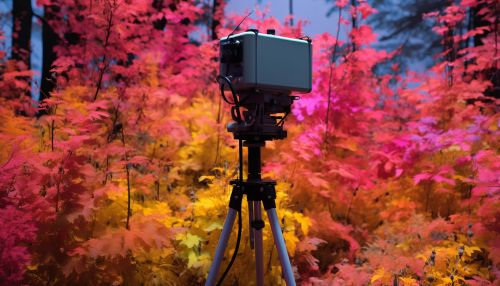Hyperspectral imaging
Introduction
Hyperspectral imaging, also known as imaging spectroscopy, is a technique used for the collection and processing of information across the electromagnetic spectrum. The goal of hyperspectral imaging is to obtain the spectrum for each pixel in the image of a scene, with the intent of finding objects, identifying materials, or detecting processes. This technique is a subset of spectral imaging, and it shares similarities with other spectral imaging methods such as multispectral imaging.
History
The concept of hyperspectral imaging originated in the 1970s and 1980s when NASA started using this technique for remote sensing and planetary exploration. The first hyperspectral imaging systems were used in the Voyager missions to study the outer planets and their moons. These early systems were large and expensive, limiting their use to space and airborne platforms.
Principle
Hyperspectral imaging works by collecting and processing information from across the electromagnetic spectrum. Unlike traditional imaging techniques that capture images in three color bands (red, green, and blue), hyperspectral imaging captures images in many, sometimes hundreds, of spectral bands. This allows for the detailed analysis of an object's spectral response, which can be used to identify and classify the object.
Techniques
There are several techniques used in hyperspectral imaging, including:
Pushbroom Scanning
In pushbroom scanning, the sensor moves over the scene in a straight line, collecting one line of spatial data at a time. This technique is often used in airborne and spaceborne hyperspectral imaging systems.
Whiskbroom Scanning
Whiskbroom scanning involves a rotating mirror that scans the scene in a back-and-forth motion. This technique is often used in ground-based hyperspectral imaging systems.
Tunable Filters
Tunable filters are used to select specific wavelengths of light for imaging. This technique is often used in laboratory-based hyperspectral imaging systems.
Applications
Hyperspectral imaging has a wide range of applications, including:
Remote Sensing
In remote sensing, hyperspectral imaging is used to identify and classify objects on the Earth's surface. This can be used for land use planning, environmental monitoring, and resource exploration.
Medical Imaging
In medical imaging, hyperspectral imaging can be used to identify and classify tissues and cells. This can be used for disease diagnosis and treatment planning.
Food Inspection
In food inspection, hyperspectral imaging can be used to identify and classify food products. This can be used for quality control and safety inspection.
Future Directions
The future of hyperspectral imaging lies in the development of smaller, cheaper, and more efficient hyperspectral imaging systems. This will allow for the wider use of hyperspectral imaging in various fields, including consumer electronics, automotive, and industrial inspection.


